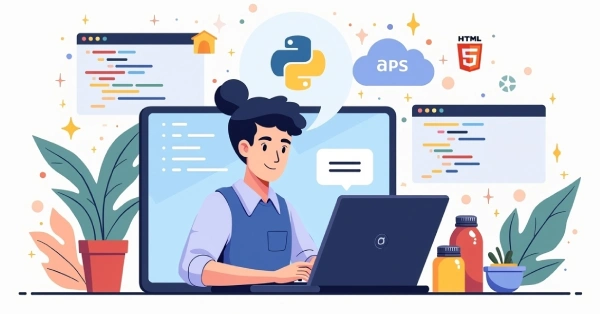Step-by-Step Guide to a Python Full Stack Development Course
In today’s IT landscape, full stack development stands out as a highly sought-after skill. By receiving proper training, you can gain expertise in both front-end and back-end technologies, enabling you to create fully functional web applications from scratch. If you’re planning to start this journey, here’s a step-by-step guide that highlights the major stages of learning and growing as a full stack developer.
In our previous blog, we explored some of the most promising career opportunities available after completing a Python course. Continuing from there, this article takes you through a structured learning journey, offering practical steps to help you confidently master Python full stack development.
Learning Path with a Python Full Stack Development Course
A Python full stack course offers a structured roadmap to master both client-side and server-side technologies. It guides learners from basic programming concepts to advanced frameworks, ensuring you gain hands-on experience in building complete applications. This structured learning path makes it easier to progress systematically toward becoming a professional full stack developer.
-
Step 1: Learning the Basics of Python
Your learning journey starts with Python, a programming language valued for its clarity and easy-to-learn syntax, making it ideal for beginners. You’ll start with programming fundamentals like variables, data types, loops, and functions before moving to advanced topics such as object-oriented programming. A strong foundation in Python ensures that you can easily transition into complex coding and back-end development tasks later on.
-
Step 2: Exploring Front-End Technologies
After getting comfortable with Python, it’s time to dive into the front end. This includes learning HTML for page structure, CSS for styling and layouts, and JavaScript for adding interactivity. Many courses also cover popular frameworks like React or Angular, which are essential for creating modern, responsive, and user-friendly web interfaces. Mastering these technologies allows you to design applications that look great and work seamlessly.
-
Step 3: Back-End Development with Python
Once the front end is clear, the next focus is back-end development. Here, frameworks such as Django and Flask come into play. You’ll learn how to build APIs, manage server requests, handle authentication, and connect applications with databases. At this stage, the true value of a Python full stack development course is realized, as it equips you with the skills to integrate multiple technologies and build complete web applications.
-
Step 4: Working with Databases
Databases form the backbone of modern web applications, making it essential to understand how they work. In a Python course, you’ll gain hands-on experience with SQL databases like MySQL and PostgreSQL for managing structured data, along with NoSQL options such as MongoDB to efficiently handle unstructured information. Understanding how to store, retrieve, and secure information is a critical step toward becoming a professional full stack developer.
-
Step 5: Version Control and Collaboration
Modern software development requires collaboration and version control. Tools like Git and GitHub are taught to help you manage code efficiently, collaborate with teams, and track changes. By practicing version control, you’ll become industry-ready and familiar with real-world workflows that companies expect from professional developers.
-
Step 6: Hands-On Projects
Learning concepts is just the first step — applying them in real projects is what truly matters. Most full stack courses include real-world projects such as building e-commerce sites, personal blogs, or portfolio platforms. These projects give you a chance to implement everything you’ve learned and showcase your skills to potential employers through a professional portfolio.
-
Step 7: Deployment and Career Preparation
The final step is all about preparing your applications for real-world use and getting ready for your career. You’ll learn how to deploy apps to live servers, ensuring they’re accessible to users worldwide. Many programs also include resume-building, mock interviews, and career guidance sessions to give you the confidence to succeed in job interviews and land your first developer role.
Conclusion
To become a successful full stack developer, you need commitment, regular hands-on practice, and a structured learning approach. By following these steps, you’ll gain the technical and practical expertise needed to build complete applications and succeed in the IT field. If you’re looking to strengthen your career prospects, enrolling in an IT course in Bangalore can give you the right platform to learn, practice, and grow into a skilled professional.






